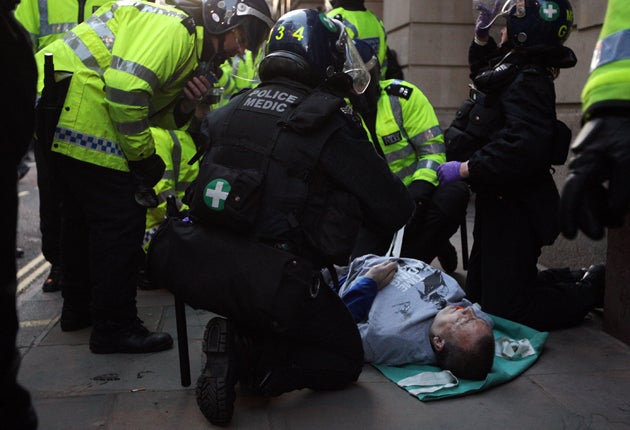A file of evidence about the death of Ian Tomlinson during the G20 demonstrations was passed to prosecutors today.
The newspaper seller died minutes after he was hit with a baton and pushed to the ground by an officer policing the City of London protest.
Solicitors at the Crown Prosecution Service (CPS) will now consider whether the territorial support group officer should be prosecuted.
The criminal investigation focused on the actions of the officer after video emerged of him striking Mr Tomlinson in Royal Exchange Passage on April 1.
A second inquiry into the complaints made by Mr Tomlinson's family, including a complaint about a media statement, is ongoing.
A spokesman said: "The IPCC has completed the criminal investigation into the actions of the officer seen to be in contact with Ian Tomlinson in Royal Exchange Passage before his death and a file of evidence has now been passed to the CPS."
Files of evidence on two other alleged assaults by police officers have also been passed to the CPS.
The first focused on an incident in which protester Nicola Fisher was hit with a baton and slapped by a territorial support group sergeant on April 2.
The alleged assault, which took place during a vigil for Mr Tomlinson outside the Bank of England, was captured by an amateur cameraman.
The second inquiry followed an allegation that a woman was assaulted by the same officer while held in an alleyway connecting Bishopsgate and Great St Helens.
Deborah Glass, of the IPCC, said: "This investigation is one of the largest ever undertaken by the IPCC and it has been the subject of huge public scrutiny.
"Our investigators have worked tirelessly to complete this large and complex investigation as quickly and efficiently as possible and we will now wait for the CPS's decision as to whether a prosecution will be brought.
"We have had a remarkable response from the public and I would like to thank those people who have contacted us for all their help.
"Much of the video evidence we have passed to the CPS was collected by members of the public on cameras or mobile phones."
The probe into Mr Tomlinson's death is at the centre of several inquiries sparked by two days of demonstrations in the City during the meeting of world leaders.
The 47-year-old clashed with lines of officers as he attempted to walk home through the City from Temple Tube station.
He collapsed and officers said they were pelted with litter as they tried to help him. A post-mortem examination found he died of a heart attack.
But an amateur video emerged several days later which showed Mr Tomlinson being struck and pushed to the ground as a line of officers followed him down a street.
A second post-mortem found he died of abdominal bleeding. A third set of tests, carried out on behalf of the officer, has not been made public.
A series of public reports has since attacked wider police tactics during the protests, including the controversial practice of penning people in.
The IPCC said more than 40 investigators and other members of staff from all over Britain have been involved in the case.
More than 190 premises were visited during a search for CCTV of the incident and footage was recovered from more than 220 cameras.
About 1,200 hours of video footage, including evidence shot from a police helicopter and by protesters, has also been reviewed.
Statements were taken from 193 members of the public and evidence collected from police officers, civilian staff and medical experts.
Forty-two people called a dedicated witness phone line, several providing important information.
The IPCC employed several outside experts, including organisations specialising in computerised scene reconstruction, video enhancement and forensic testing.
A specialist team also trawled the internet for associated footage and messages were posted on YouTube asking owners of useful footage to contact the IPCC.
Mr Tomlinson's widow, Julia, called on the CPS to prosecute the officer as soon as possible and let a jury decide if he is guilty.
She said: "It has been a very difficult four months since Ian died and it is a relief to see some progress.
"The last information that the coroner put out was Dr Cary's view that Ian died from internal bleeding.
"Video footage made it clear to us, and everyone else, that Ian was the victim of an unprovoked assault by a police officer.
"If there is going to be any justice then it must be left for a jury to decide if the police officer is guilty of killing Ian.
"I hope the CPS will get the case in front of a jury as soon as possible. We would like to thank everyone who came forward as witnesses."
Dr Nathaniel Cary was the Home Office pathologist, one of the most respected in Britain, who performed the second post-mortem examination.

Join our commenting forum
Join thought-provoking conversations, follow other Independent readers and see their replies
Comments